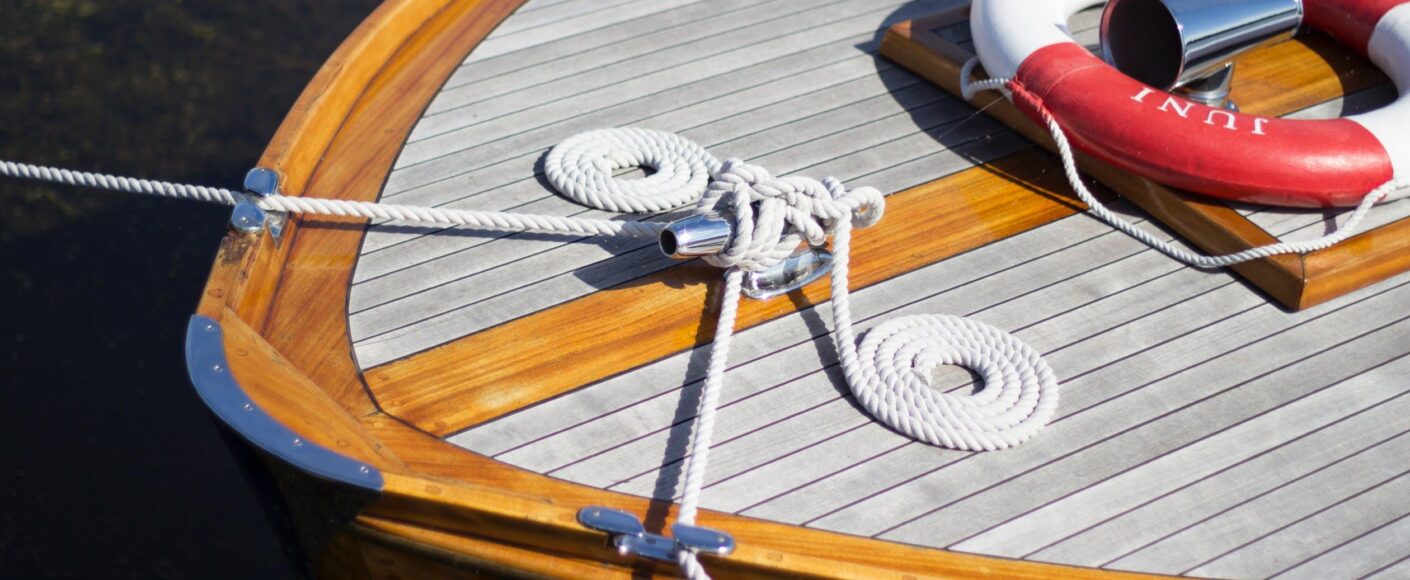Types of Boat Deck Sealants and Their Uses

Protecting boats from the ravages of saltwater, air, and the sun is an effort as old as boating itself. The earliest sailors and boatbuilders, beginning with oared boats, were confronted with the same challenge faced by today’s recreational boaters — to protect their vessels from the elements, and to make them watertight enough to float without taking on water.
Vessels of Native Americans, Vikings, and other sailing nations show evidence of extensive use of organic materials in hull and deck sealing and repair. The material was typically a pitch- or tar-based product, first using tree sap, then animal by-products, such as cartilage, sinew, horns, and rendered animal fat, and fossil-fuel-based material. Later, pine tar was used to waterproof hulls and rigging, which worked reasonably well and required no more maintenance than the rest of the vessel. However, because they were organic, they eventually dried out or decayed.
Today’s boaters use the leaping advances in chemistry and application technologies over the years to repair and protect boat decks and other components. This article touches on the basics of deck sealants, offers tips for use, and presents information about wooden deck sealing.
Marine Sealants
Basically, three types of chemicals are used in marine sealants: silicones, polysulfides, and polyurethanes, which form a watertight and airtight seal between two or more surfaces. Sealants are designed to: protect surfaces by forming a water- and/or airtight seal between two or more surfaces; assist in joining the surfaces together, often with mechanical fasteners; and, finally, to isolate surfaces to help prevent the passage of noise or electricity.
Marine retailers offer a range of sealants, but selecting the right one for a particular project can be pretty straightforward. Almost all modern marine sealants are of just three types: polysulfide, silicone, and polyurethane. Each has specific characteristics and applications that make one the right choice for a project. Selecting the right sealant is essentially a matter of identifying the materials to be sealed and determining whether the materials/equipment will ever need to be separated or removed. It is also important to consider the location of the item to be sealed, especially referring to whether it is above or below the waterline. Certainly, there are exceptions, but the following guidelines will help avoid most errors.
- Silicone will insulate non-similar metals and beds plastic.
- Polyurethane should only be used to join materials that will not need to be separated.
- Use polysulfide for everything else.
Polyurethane, silicone and polysulfide sealants are described briefly below.
Polyurethane — A blend of materials in a base of urea, a naturally occurring by-product of metabolism. More of an adhesive than a sealant, polyurethane is recommended for permanent bonding because of its adhesive strength and useful for hull/deck joints and bonding through-hull fittings, but is incompatible with most plastic materials. Polyurethanes have poor resistance to oil and acids used in products like teak cleaners and should not be used if the bonded items may have to be separated in the future.
Silicone — Easy to apply, silicone is elastic, highly resistant to chemicals and the best material for isolating dissimilar metals. Adhesion is not as strong as a polysulfide or polyurethane is more of a gasket material than a sealant, but is compatible with plastics. Silicone leaves a residue that is difficult to remove, and nothing will adhere to it, including fresh silicone or paint (polyurethane, polyether, and polysulfide can be painted).
Polysulfide — Made of synthetic rubber, it is the most versatile type of sealant and comes in one- and two-part application methods. Two-parters are popular as caulking material for teak decks or for bedding wood parts like rub rails and cockpit coamings. One-part polysulfides are easy to use and durable, but cure slowly. Both types bond well to most surfaces, but should not be used for plastic deck fittings, frames or acrylic or polycarbonate windshields.
Recent advances in epoxy sealant technology make it a viable sealant choice. Newer products are more flexible and less brittle than older versions and cure faster than some polyurethanes, Epoxies adhere well to fiberglass, wood, steel, and aluminum, and can be manipulated afterwards without cracking.
Tips for using sealants:
- Follow product safety and application instructions to the letter.
- The preparation for any sealant project is critical; surfaces should be clean, dry, and free of old sealant. Mating surfaces should be cleaned with acetone or similar product and be thoroughly dry before applying new material.
- Depending on manufacturer instructions, using liberal amounts of the material is important, particularly when joining hardware to decks.
- All marine sealants have various curing periods, ranging from 5 to 20 days. Generally, the strongest products take the longest to cure. Moisture in the air or dew may accelerate polysulfide or polyurethane curing time.
- If using mechanical fasteners with a sealant, tighten the nuts, not the bolts in through-bolt applications. Compressing the sealant ensures a watertight bond.
- Doing a sealing project as a do-it-yourselfer requires a well-ventilated work area, that all sealants, tools, and cleaning materials are readily available, and that guidelines regarding personal protection use (masks, gloves, etc.) are followed.
- Take manufacturer statements about the permanency of sealants seriously, especially when it comes to removing materials from skin.
- Mineral spirits, acetone, and kerosene are typically used to remove excess, spilled, or misapplied sealants. Closely follow manufacturer guidelines regarding the type of solvent for clean up and spot removal.
Finishing Wooden Boat Decks
Well-maintained wooden decks not only enhance a vessel’s appearance, they also help to provide a safe working environment, particularly on sailboats. Maintaining wood decks, especially those of teak or mahogany, can be a real challenge, both in terms of effort and the materials used as sealants.
Wooden deck sealers serve two purposes: to stop moisture and dirt intrusion, and to retain natural wood oils and resins. The combination of materials used to maintain wood decks involve cleaners, primers, oils, and varnishes; the process to properly clean and seal wood decks is time consuming and requires much effort over more than a few days. Regardless of the type of deck wood, the following tips will provide some guidance for a wood deck cleaning and sealing project.
- Make sure that the deck wood is correctly identified (teak, mahogany, pine, ash, etc.) and purchase cleaner, primer, and sealant products appropriate for the material.
- Seek the advice of boaters who have decks of identical type and ask for their assistance during the project.
- Follow directions for primer, cleaner, wood oil (if needed), and varnish applications; pay particular attention to guidelines for air temperature, humidly level and drying times.
- Ensure that the surface is clean and free of debris and that removable equipment is removed and stowed below deck or off the boat.
- Allow for plenty of time for curing and drying — even extending the duration if possible.
- Avoid the temptation to shorten drying times or eliminating coats, particularly varnish.
- Maintain the deck by washing and applying a new coat of sealer every 2-3 months.
- If using wood oils (especially teak), be prepared to apply several coats over several days.
Varnish or Synthetic Finishes for Boat Decks
Varnish and wood oils have been the traditional transparent wood finishes on boats for hundreds of years. Without pigment, they allow the beauty of the wood grain to show while protecting it from sunlight, salt water, dirt, and abrasion. Aside from its much-admired appearance, varnish offers genuine protection — varnished wood will not dry out or split, will not absorb moisture, is unaffected by dirt and pollution, and will repel oil or grease spills. However, as varnishes act as a layer coating the wood, it can break down and typically needs reapplying annually.
Synthetic finishes are popular with cruisers in the tropics seeking UV-resistant, low-maintenance coatings. Applying a synthetic finish is easy and quick and results in a durable and handsome appearance. Synthetic finish pigments protect the wood’s lignin, but degrade over time with exposure to ultraviolet light. Multiple applications are typical and air temperature, humidity, and drying time between coats are critical issues.
The practice of protecting boats from the elements is as old as boating itself. Today’s technology makes it easier for boaters to effectively shield their vessels from saltwater, sun, and moisture, and to maintain a handsome and safe boat.



